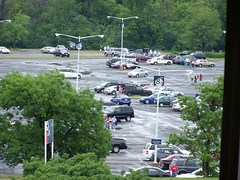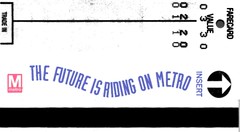Baseball, Hot Dogs, Apple Pie and Transportation Demand Management
 Photo by Mike Kepika of the San Francisco Chronicle. People leaving the streetcars to see a Giants game at PacBell Park.
Photo by Mike Kepika of the San Francisco Chronicle. People leaving the streetcars to see a Giants game at PacBell Park. Yesterday's Close to Home section in the Post also has a pro-automobile letter from a suburban denizen, "Don't Drive Away Nats Fans," about the big picture really being "insufficient parking spaces" in the vicinity of the baseball park, not the concern of us urbanists to have great experiences streetside, which means parking underground.
(Today's Post also has a piece about creating a "district" around and beyond the ballpark, which the Anacostia Waterfront Corporation is working on busily with various members of the local Growth Machine. See "Anacostia Group Looks Beyond the Ballpark," by Dana Hedgpeth.)
Ken Reid writes:
The stadium will not have enough parking spots, and with Metro's capacity constraints, I'm afraid that the lack of parking could dampen attendance and hurt the team and the city. According to a June 8 Metro story, the 1,225 parking spaces "likely will go to holders of high-priced tickets and patrons of luxury suites." This accommodates at most 5,000 fans, assuming you can fit four or five in a car. The rest of us who are in the "cheap seats" will have to take Metro.
Suburbanites seem to form the major market for the Nationals; just scan the license plates at RFK Stadium. Without adequate parking and with ever-increasing prices for food and tickets, the Nationals will be driving away their base of support.
Driving to the stadium is cheaper and faster than taking Metro. There are at least 10,000 parking spaces at RFK, and Eastern High School sells spaces, too. If I took Metro from my home in Leesburg to RFK, I would have to drive to the East or West Falls Church Metro station, park and then wait for a train. Parking at Metro is free on weekends, but not during the week.
 Lot 8, RFK. Flickr photo by Big Cat.
Lot 8, RFK. Flickr photo by Big Cat.For a family of four, taking Metro from East Falls Church to RFK Stadium costs $18.80 round-trip at off-peak hours, and $23.80 during peak hours. It costs just $12 to park at RFK. The saving in gas is not that great (we own fuel-efficient cars).
The cost to take Metro from East Falls Church to the Navy Yard for a family of four is $14.80 off-peak, $18.80 peak. But with the new stadium, most Nats fans, and especially season ticket-holders, will have to take Metro, thus adding more time to the trip and making this an expensive and arduous proposition.
I'm not going to berate Mr. Reid, because he raises an important issue, "Transportation Demand Management" should be a fundamental part of big projects like this.
I don't think it happens with as broad brush as it needs to be.
Maybe the Lerners, DDOT, and WMATA need to get together and do some out-of-the-box thinking about creating special family Metropasses for baseball, working with out-country transportation systems (like Loudon Transit or OmniRide in Prince William, etc.), to create special transit options that discourage driving.
Why should our limited land base in the city be burdened with providing parking for denizens of Leesburg?, people who free ride in part on our WMATA system anyway because they don't participate in the WMATA compact, even though thousands of Prince William County residents use the system each day.
But rather than berate them, maybe we need to get creative and figure out how to make this work for them, at less than $19-$24 round-trip for four people? This could be extended to professional basketball and hockey as well.
Perhaps it could even be worked out with Ticketmaster and similar organizations to sell/bundle special transit passes along with events tickets for concerts, theater, etc.
It's worth "the subsidy" to get them off the roads and onto the extant transit system. A model that should be looked to is how transit systems provide special transit passes and options to college students.
It's also another way to encourage people who might not be regular transit riders to sample public transportation. As Mr. Reid says:
Nats and D.C. officials are living in a dream world if they think everyone can and will use Metro. It is a good system, but one that is used for just 3 percent of all trips taken in the Washington area, according to the Metropolitan Washington Council of Governments.
I look at this as another opportunity to challenge this way of thinking and build the awareness, usage, and support of public transportation.
(And about Mr. Reid's comments about parking lots promoting tailgating, which boosts pride in the team and camaraderie, well, I think DC residents are paying enough for the stadium as it is. More parking comes at too great a cost considering all the money that's going into this, as well as the displacement of businesses and cultural organizations, and how much money DC residents have put into the public transportation system on a per capita basis, compared to the suburban residents of the region. If the Lerners want parking-lot camaraderie, is it really asking too much for them to pay for it themselves--just this once?)

Index Keywords: mobility; car-culture; transportation-demand-management; stadiums-arenas



0 Comments:
Post a Comment
<< Home